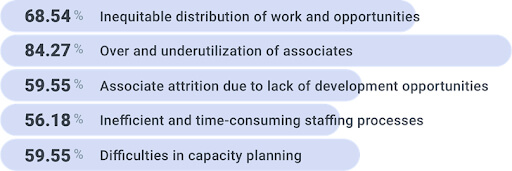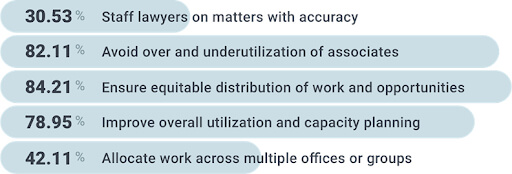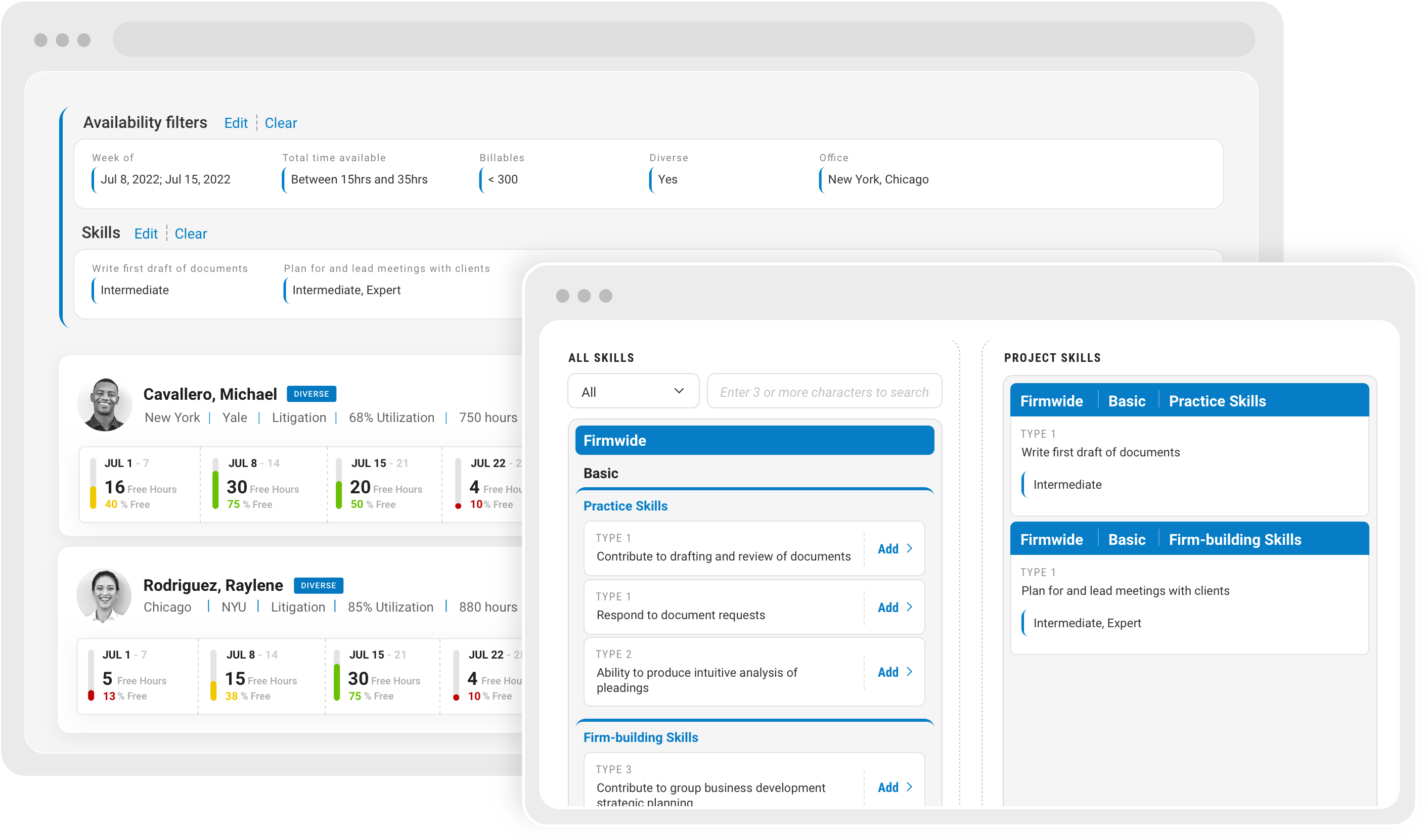In our recent webinar with the International Legal Technology Association, “Lawyer Work Allocation and Resource Management: How to Do Better with Technology,” vi by Aderant covered trends in the legal industry, the problems that law firms are facing, and why firms are looking to improve their resource allocation. During the webinar, we surveyed the more than 100 law firms in attendance on these topics.
As a global leader in legal talent management solutions, vi by Aderant works with more than 400 law firms around the world, including 95% of the Am Law 100. Based on our experience working with law firms, we have seen these major trends impact the legal industry in recent years:
- Diversity, equity, and inclusion (DE&I) is becoming a business imperative, increasing the need for equitable distribution of work and opportunities to associates.
- Remote work had been disrupting assignment processes since the beginning of the pandemic, thanks to a lack of visibility into associate assignments and workloads.
- The demographic shift in the workforce means lawyers value growth opportunities, autonomy, and work-life balance more than previous generations.
- The high attrition of associates from Big Law has fueled the lateral recruiting market. Firms that are unable to adapt and reinvent themselves continue to lose talent.
- Firms are moving to centralized resource management to boost utilization and allocate work across multiple groups and office locations.
When asked which trends are affecting their firm (selecting all that applied), 90% of webinar respondents said DE&I. More than half said high attrition, remote work, and moving to centralized resource management, and over a third said the demographic shift.

The resource allocation problems facing law firms
We dug deeper into these resource allocation trends to pinpoint the major challenges that law firms are facing when it comes to resource management and work allocation. Here are the problems we found.
- Inequitable distribution of work and opportunities: Traditional partner-led work distribution is ripe for implicit bias. Some associates end up with better training and more important work, while others are underutilized regardless of their potential. Partners can dominate the “good” associates and limit the resource pool for other partners. This inequality gets more entrenched over time, as go-to associates continue to improve while others are left behind.
- Over and underutilization of associates: Overutilized associates are billing more than 200 hours a month and burning out from overwork. Underutilized associates are billing under 160 hours, and are not getting enough work to hit their billable targets or develop their skills. Both extremes can lead to associate attrition, and managers often aren’t aware of the problem until it’s too late.
- Associate attrition due to lack of development opportunities: Associates have no say in the type of work they get or who they work with, and they will leave for better opportunities if they aren’t getting what they want. A NALP Foundation survey reveals that work quality is the top reason associates leave firms. This has only been exacerbated by trends such as DE&I, remote work during COVID, and the demographic shift. Firms can’t afford to ignore it.
- Difficulties in capacity planning: Associate availability and firm capacity are difficult to forecast, especially without a system in place. Partners and managers are unable to see when they need to shift resources around or do more hiring. They’re looking into the future and trying to predict what needs to be done to be at full capacity in two weeks, a month, or even six months.
- Inefficient and time-consuming staffing processes: It takes a lot of time and back and forth to find the right lawyers for each matter or project. Emailing or calling to figure out who is available can be a nightmare, especially as a firm grows and there are numerous practice groups or office locations. Work needs to be assigned fast, and the best decisions are going to take into account associate availability, skills, and more.
When asked what resource allocation problems resonated with their firm, the top answers from the webinar attendees were over and underutilization of associates and inequitable distribution of work and opportunities.

The reasons firms are looking for resource allocation solutions
More and more law firms are exploring comprehensive resource allocation solutions that can help them solve these problems. Here are the top reasons firms are seeking solutions:
- Ensuring equitable distribution of work and opportunities: Firms want to know when associates are overlooked and might end up underdeveloped. This will allow them to correct when an associate has a gap in their work experience, or when they keep getting the same type of paperwork over and over instead of getting to work with clients.
- Avoiding over and underutilization of associates: With real-time visibility into associate utilization and availability, firms can ensure that every individual stays working at capacity. By making sure that no one is over or underutilized, they will reduce the risk of burnout, attrition, or underdevelopment.
- Improving overall utilization and capacity planning: Firms have a high volume of work and limited resources to cover it. Visibility into associate work and availability will help maximize every associate’s calendar while keeping work balanced and varied. They can also ensure that they have enough resources and know when to hire more staff.
- Allocating work across multiple offices or groups: Cross-practice and cross-office collaboration is only easy if firms can see who is available and how they can help. The pandemic also showed firms that their people can work from anywhere, leading some of them to create pools of associates that they can staff on projects regardless of location.
- Staffing lawyers on matters with accuracy: Firms have a lot of data about their lawyers, but the process can still be less efficient or effective than desired. A system that brings together associate availability, utilization, demographics, skills, and interests can drive quick and informed decisions about who to staff on each matter or project.
When we asked our webinar why their firms are looking for resource allocation solutions, ensuring equitable distribution of work and avoiding over and underutilization of associates topped the poll. This corresponds with the top challenges question, where over and underutilization and inequitable work distribution were also in the lead.

What law firms need in a resource allocation system
vi by Aderant had the opportunity to work closely with law firms to identify what an efficient and effective resource allocation system means for them, the functionalities they need, and the technological requirements to deliver those functionalities. Here’s what we’ve learned from them:
- Law firms want a system that allows them to allocate work to lawyers based on their availability, skills, development needs, demographics, and interests. Some want to include internal ratings and feedback on associates, determined by real-time feedback from partners on completed matters.
- Firms need real-time tracking of associate workloads and assignments. This will allow them to review each associate’s utilization rate and hours billed, as well as look forward to their forecasted availability and assigned matters. They can also compare self-reported associate forecasts with their actual billables to improve forecast accuracy.
- Many firms are interested in tracking associate skills and development needs. They want to layer skills on top of other work allocation criteria by identifying firm-wide and practice group competencies. This will allow associates to track the skills they acquire on each matter and see which ones they need to develop in order to advance.
- To make all of the above happen, law firms require centralized data in an all-in-one system that integrates with their HR and time/billing systems. This is crucial to ensuring the accuracy of data and ease of use for everyone involved. The system also needs the flexibility to support different workflows for different groups and departments.
Learn more about vi by Aderant’s resource allocation solution for law firms
vi by Aderant developed viResourceAllocation specifically for law firm work allocation and resource management needs.
Our software includes all of the above-mentioned functionalities, and helps law firms streamline their workflows and centralize data across their offices. Law firms can easily report on important metrics such as individual and team capacity, associates at risk of under and overutilization, associate development progress, DE&I progress, etc.
An effective resource allocation system can make a world of difference for your firm. Contact us today to learn more!
